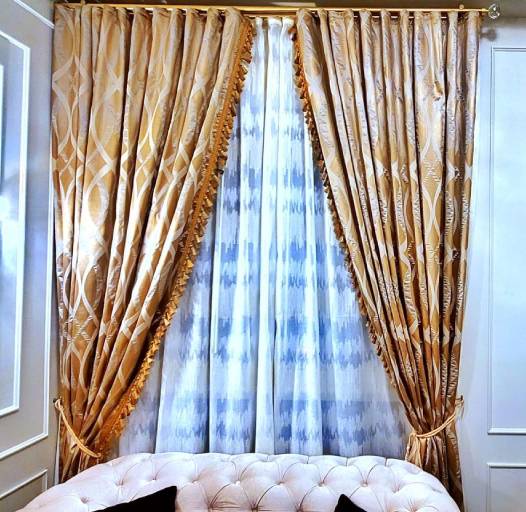
ELEGANT COVERING
Unique curtains can add a distinct and personalized touch to your home while providing effective window coverings.
Curtains
Unique curtains can add a distinct and personalized touch to your home while providing effective window coverings. Curtains are manufactured from a variety of thick fabrics, each with a differing degree of light absorption and heat insulating qualities. For maximum temperature control, the curtain gap to the window should be small, with minimum convection drafts below or above the curtain. Various architectural structures around the curtain can minimize these air drafts, but usually they are just used for decoration and make rooms feel cozier.
Sheer or Net Curtains
A sheer or net curtain is one that is made from translucent fabric, such as a loosely woven polyester, voile, silk or nylon made marquisette, or ninon and cotton lace, etc. Sheer curtains allow a majority of light to be transmitted through the fabric, with the fabric weave providing a basic level of UV protection while retaining maximum visibility outward through the curtain. Sheer curtains are sometimes referred to as "privacy curtains" in reference to their screening abilities; during the day most sheer fabrics will allow people inside the home to see the outside view while preventing people outside the home from seeing directly into the home. Due to the loose weave in sheer fabrics, these types of curtains offer very little in the way of heat insulation.
Uncoated Fabrics Curtains
Uncoated fabrics provide the next level of heat insulation and light absorption. Uncoated fabrics constitute the vast majority of fabrics used in curtains, and are composed of a tightly woven fabric, most typically a cotton/polyester blend, which is mostly opaque when viewed in ambient light. Uncoated fabrics provide a reasonable level of heat insulation due to their tight weaves, but are too thin to completely absorb strong light. As a result, when curtains made from uncoated fabrics are closed in an attempt to block out direct sunlight, light will still be visible through the curtain because its textiles are shiny.
Uncoated Fabrics Curtains
Uncoated fabrics consist of a standard uncoated fabric with an opaque rubber backing applied to the rear of the fabric to provide improved light absorption. To create a coated fabric, a liquefied rubber polymer is applied in a single coat to an uncoated fabric and subsequently fused dry by means of a heated roller, in much the same way that a laser printer applies toner to a sheet of paper before fusing it dry. A fabric that has been through the coating process once is considered a "1-pass-coated" fabric, anecdotally referred to as "dim-out" or “blackout” because of the fabric's ability to absorb approximately 50-70% of a direct light source. To improve the light absorption of a fabric it is possible to re-coat a fabric up to a maximum of "3-pass-coated", which is considered sufficient to block out 100% of a direct light source, hence such fabrics are referred to as “blackout” coated.
Styles
Curtains can be used to give a room a focal point. There are at least twenty different styles of curtains and draperies which can be used in window treatment.
- Flat panel curtains are simple and versatile: to make them, pieces of fabric are hemmed on all four edges and the final rectangular or square piece is hung from curtains poles with clip-on rings or something similar. If pleated, the look is strongly influenced by the fullness of the pleats.
- Panel Pair curtains are also known as double panel curtains. They refer to two curtain panels hanging on either side of the window. This is the most common style.
- Tab top curtains are made with narrow straps, that loop or tie at the top edge and hung from the curtain pole. This curtain style is often designed as two stationary panels at the sides of a window.
- Grommet curtains are hung by threading the curtain pole through a hole in the top of the fabric. This could be either a cut-out hole with the edges finished by a row of stitching or it could use a grommet to prevent fraying.
- Sash curtains are used to cover the lower sash of the windows.
- Rod pocket curtains have a channel sewn into the top of the fabric. A curtain rod is passed through the channel to hang.
- Thermalor blackout curtains use very tightly woven fabric, usually in multiple layers. They not only block out the light, but can also serve as an acoustic or thermal dampener.
- Curtain liners are used to protect actual curtains from getting wet.

Innovation begins with us.
Elevate your windows into masterpieces with our elegant solution.
Let's dive into crafting!
Whether you’re looking to simply update your current window fashions or give a room a complete makeover.
